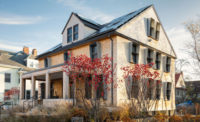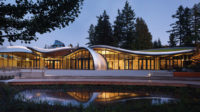Engineering News-Record
Ultra-Green Brock Center Certified as a 'Living Building'

Brock Environmental Center uses 80% less energy than an average building and is the first U.S. building permitted to "drink" its rainwater.

Brock Environmental Center uses 80% less energy than an average building and is the first U.S. building permitted to "drink" its rainwater.
Photo © Dave Chance Photography


This story originally ran in Engineering News-Record on May 25, 2016.
Earlier this month, the first building in the U.S. permitted to treat rainwater for potable uses also became a Living Building—the highest level of ultra-green-building certification granted by the International Living Future Institute. The 10,520-sq-ft Brock Environmental Center in Virginia Beach, Va., is one of 44 buildings to have achieved partial or full certification under ILFI’s decade-old Living Building Challenge, which is considered the most rigorous sustainable design, construction and performance standard.
Over the course of a year, Brock produced 1.83 times more energy than it consumed. The building’s performance “far surpassed all of our goals,” said Mary Tod Winchester, vice president of administration and operations for Brock’s owner, the Chesapeake Bay Foundation (CBF), at ILFI’s “Living Future 2016” conference. The 10th annual gathering, held May 11-13 in Seattle, had 931 attendees.
Living Building candidates achieve certification only if their teams meet strict performance goals around energy and water use. Buildings registered for the Living Building Challenge do not receive certification until at least a year after the buildings are fully occupied.
Consequently, for the designers, a Living Building project has three phases: design, construction and postconstruction, said Greg Mella, principal in charge of the $8-million building for SmithGroupJJR, Brock’s architect and mechanical-electrical-plumbing engineer. “Every day for a year, I would get an email at 12:04 a.m., detailing energy and water use,” said Mella.
In alignment with CBF’s environmental educational mission, the Brock team is sharing information about the project, including the many lessons learned.
Drinking Rainwater
Brock had to become a public waterworks to gain regulatory approval to treat rainwater for potable use (ENR 3/14 p. 49). “It’s been a fun challenge,” says Chris Gorri, Brock’s manager. In addition to daily system monitoring by trained building staff, a consultant comes every month.
In its first year of operation, the building had an energy-use intensity of 14.12, which represents an 80% savings over an average building with an EUI of 69.82, said Mella. The Brock team had predicted an EUI of 16.
Brock harvests energy from 46.5 kW of installed solar photovoltaics and two on-site 10-kW wind turbines. The 70-ft-tall turbines have a 38-year payback period, mostly because poor soils required 100-ft-deep piles.
“It was courageous” for the foundation to include turbines because the community, fearful of bird kill, fought them, said Mella, adding, “There has been relatively little bird kill.”
Compared to the average non-residential building, Brock, which houses a staff of 25, used 96% less energy for lighting; 86% less energy for electric-plug loads; 67% less energy for heating and cooling; 51% less energy for ventilation; and 40% less energy for hot water, said Mella.
The building used half the lighting energy predicted. A long, narrow floor plate and no adjacent buildings helped maximize daylighting.
Plug loads typically account for 25% of the power used in buildings. They are difficult to predict because occupant behavior is somewhat unknown, said Mella. Brock’s team accurately predicted plug loads, but Mella advises design teams to be mindful of plug-load creep over time.
Brock has energy-efficient copiers and laptop monitors. A kill switch automatically shuts down computers and other equipment at night, said Gorri.
CBF’s headquarters, the 15-year-old Philip Merrill Environmental Center in Annapolis, was the first LEED Platinum building. “We raised the bar with the Merrill center, and we knew we could raise the bar again,” said Winchester. “The Living Building Challenge provided that road map.


